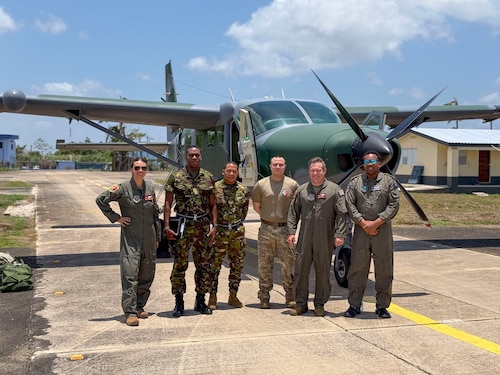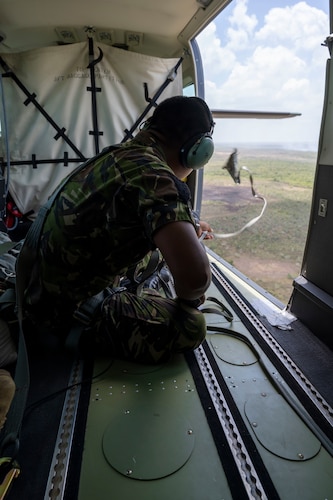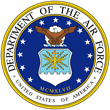Strengthening Ties, Securing Borders: U.S., Belize Partner to Combat Drug Cartels

U.S. Air Force Airmen from the 571st Mobility Support Advisory Squadron, guide Belize Defence Force members on installing an air deflector toa C-208 Grand Caravan during a training mission in Ladyville, Belize, May 26, 2025. The training aimed to enhance the BDF’s ability to conduct aerial resupply operations. (U.S. Air Force photo by Tech. Sgt. Levi Reynolds)
Recognizing this threat, Belize acquired a U.S. manufactured C-208 Grand Caravan in 2023, equipped with a sophisticated MX-15 sensor and an AERONet communication system - a powerful combination capable of detecting and monitoring cartel movements. However, possessing the technology is only half the battle. Belize needed the technical expertise and training to fully leverage the C-208's capabilities.

A U.S. Air Force Airman from the 571st Mobility Support Advisory Squadron, evaluates Belize Defence Force members on drop zone operations as a C-208 Grand Caravan air drops as package during a training mission in Ladyville, Belize, May 26, 2025. The training aimed to enhance the BDF’s ability to conduct aerial resupply operations. (U.S. Air Force photo by Tech. Sgt. Levi Reynolds)
Their mission: to empower the Belize Defence Force (BDF) to strengthen its rule of law, thwart cartel activity within its borders, and ultimately contribute to the security of the U.S. southern border. This collaborative effort directly supports U.S. efforts to combat drug trafficking at its source.
“This training mission reflects the U.S.’s focus on protecting its southern border by addressing the root of the problem,” explained Lieutenant Colonel Mary Lea Bordelon, 571st MSAS Commander. “By strengthening our partners and helping them become more effective, we can disrupt cartel activity before it ever reaches our borders.”

A U.S. Air Force Airman from the 571st Mobility Support Advisory Squadron, instructs Belize Defence Force members on rigging packages to airdrop from a C-208 Grand Caravan during a training mission in Ladyville, Belize, May 26, 2025. The training aimed to enhance the BDF’s ability to conduct aerial resupply operations. (U.S. Air Force photo by Tech. Sgt. Levi Reynolds)

U.S. Air Force Airmen from the 571st Mobility Support Advisory Squadron, guide Belize Defence Force members on installing an air deflector toa C-208 Grand Caravan during a training mission in Ladyville, Belize, May 26, 2025. The training aimed to enhance the BDF’s ability to conduct aerial resupply operations. (U.S. Air Force photo by Tech. Sgt. Levi Reynolds)

A Belize Defence Force member retrieves the static line during an air drop training mission in Ladyville, Belize, May 26, 2025. The training aimed to enhance the BDF’s ability to conduct aerial resupply operations. (U.S. Air Force photo by Tech. Sgt. Levi Reynolds)
The increased capabilities are already making a difference. Captain Correa of the Belize Defence Force Air Wing noted, “The cartel activity has really been in decline of late, [thanks] in big part to our increased capabilities, particularly our ability to operate at night.” The landing zone and nighttime training provided by the 571st MSAS has enabled the BDF Air Wing to operate at auxiliary fields during hours of darkness, the cartels’ preferred time for operations.
With enhanced technology, expert training, and a strengthened partnership, Belize is sending a clear message: its territory is no longer a safe haven for drug cartels. The collaborative efforts between the U.S. and Belize are proving to be a powerful force in the fight against transnational crime.
